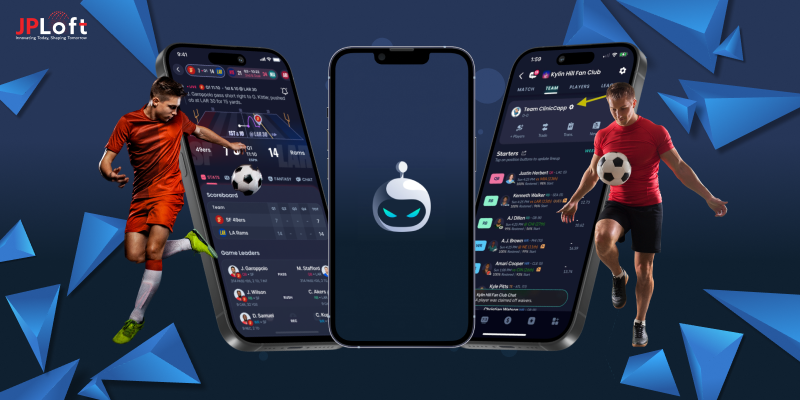Fantasy football apps are trending, but creating one is far more complex than just assembling your ideal team.
From the very beginning, developers face multiple challenges while developing a fantasy football app that can impact everything from performance to user satisfaction.
Whether you’re a startup or an established company, understanding these hurdles is crucial for long-term success. In this blog, we’ll walk you through the list of fantasy football app challenges that developers often encounter and more importantly, how to overcome them.
So, if you're planning to build a winning app, this guide is your first step toward a flawless game day experience.
Market Statistics of Fantasy Football App
If you want to develop a fantasy football app, understanding the current market landscape is essential before tackling the core fantasy football app development challenges. Here are some key insights:
-
- As per Grand View Research, the fantasy football app market was valued at $24.85 billion in 2024 and is expected to grow to $56.38 billion by 2030, registering a CAGR of 15.2% between 2025 and 2030.
- Features like lineup optimization and predictive analytics, powered by AI-driven insights, are becoming crucial in fantasy football apps.
- According to Market Growth Reports, more than 80% of fantasy players engage with the app weekly, and fantasy platforms experience an 18% surge in new users during the NFL season.
- Micro and short-duration contests are on the rise, accounting for 61% of mobile entries, appealing to users who prefer fast-paced and engaging gameplay.
- A study by Mordor Intelligence reveals that the U.S. has a strong user base, with around 62.5 million fantasy sports players in North America, 79% of whom play fantasy football.
With such rapid market growth and high user engagement, it’s clear that fantasy football apps hold incredible potential. But building a successful app in this competitive space is not without obstacles.
Let’s now explore the top development challenges of a fantasy football app that every entrepreneur and developer should be prepared for.
Major Challenges of Fantasy Football App
Building a fantasy football app sounds like an exciting venture, but once you get started, you quickly realize it’s not all smooth sailing.
There are several fantasy football app development challenges that developers and businesses face, from technical roadblocks to user engagement and legal concerns.
Let’s break down the ultimate guide to development challenges of a fantasy football app.
1. Real-Time Data Integration & Live Updates
One of the main development challenges of a fantasy football app is integrating real-time data, because fantasy football thrives on live match statistics like player scores, injuries, substitutions, and team lineups.
Users expect accurate, real-time performance updates with zero delay. If this data is even slightly off or delayed, it can frustrate users and ruin the entire experience.
Handling massive live data streams, syncing them across devices, and updating scores in real time are among the biggest development challenges in fantasy football app creation.
Solution:
Use Trusted Sports Data Providers & Optimized APIs To tackle this, developers must invest in reliable sports data providers and optimize backend infrastructure.
-
- Integrate APIs from trusted providers like SportsRadar or FantasyData.
- Use caching strategies to reduce server load during peak times.
- Implement WebSocket or push notification mechanisms for instant updates.
- Conduct real-time testing under load to avoid latency issues.
2. Designing an Intuitive & Seamless UI/UX
User interface matters.
One of the less obvious but critical challenges while developing a fantasy football app is designing a simple, intuitive, and interactive interface that users can navigate easily, even during a live match.
If the app is hard to use, people won’t stay. A messy layout, confusing team selection, or delayed navigation can turn users away, even if your app is loaded with features of fantasy football apps.
Solution:
Focus on User-Centric Design your UI for the average user, not just the fantasy football pros. A solid user experience starts early, with strategic app wireframing and app prototyping to visualize the layout and flow before development begins.
-
- Keep navigation simple, especially for core actions like joining contests or creating teams.
- Highlight important actions with clear CTAs.
- Use real-time feedback (e.g., loading spinners, progress bars).
- Test your design with different user groups before launch.
3. Scalability & Server Load Management
Fantasy football apps experience high traffic spikes, especially during live matches or tournament seasons.
Without scalable infrastructure, your app could crash at the worst possible time, damaging your reputation and user trust.
This is one of the most common development challenges for a fantasy football app and becomes even more critical as the user base grows. If you're planning to create an app that can handle millions of users, scalability must be a top priority.
Solution:
Adopt Scalable Cloud-Based Architecture You need a backend that can grow with your user base without compromising performance.
-
- Use cloud services like AWS, Google Cloud, or Azure for on-demand scalability.
- Implement auto-scaling and load-balancing tools to manage peak traffic.
- Optimize your database queries to improve response time.
- Use content delivery networks (CDNs) for faster content loading.
4. User Retention & Engagement
Even the best-designed app can fail if users stop coming back. Keeping users engaged season after season is one of the top development challenges of a fantasy football app.
With so many competitors offering similar features, users are quick to uninstall apps that feel boring or outdated. This becomes a challenge while building a fantasy football app that not only attracts but retains users.
Solution:
Gamify & Personalize the Experience A fun, personalized experience keeps users coming back. To boost retention, it's important to create an AI app experience that understands user behavior and adapts to their preferences in real-time.
-
- Add loyalty programs, rewards, and badges for achievements.
- Offer push notifications for live match events and app updates.
- Integrate chat, forums, or social sharing to build community.
- Use AI/ML to offer player suggestions, win predictions, and strategy tips.
5. Multi-Platform Compatibility & Cross-Device Sync
Today’s users expect to start building their team on one device and finish it on another.
Ensuring your fantasy football app works smoothly across Android, iOS, tablets, and web platforms is a challenge for fantasy football apps worldwide.
Cross-platform sync, real-time session management, and data consistency are critical fantasy football app development challenges, especially when aiming to develop a fantasy football app like NFL, which sets the standard in seamless user experience across all platforms.
Solution:
Build with Cross-Platform Tools & Real-Time Sync Features Make sure the experience is seamless, no matter what screen the user is on. To achieve this level of performance and consistency, it's a smart move to hire dedicated developers who specialize in cross-platform frameworks and sync technologies.
-
- Use frameworks like Flutter or React Native for efficient cross-platform development.
- Use Firebase or AWS AppSync for real-time syncing between devices.
- Ensure UI responsiveness across various screen sizes and orientations.
- Regularly test device-specific compatibility.
6. Secure Payment Integration & Fraud Prevention
Monetization is key in fantasy sports apps, but when real money is involved, security becomes a major concern.
Ensuring secure payment gateways, protecting user data, and preventing fraud are major development challenges of fantasy football app projects.
Even one security breach can ruin user trust and lead to serious legal and financial consequences.
That’s why it's crucial to partner with the best mobile app development company, one that understands secure architecture, compliance standards, and fraud detection mechanisms to safeguard your platform and users.
Solution:
Use Secure, Compliant Payment Gateways Protect your users and your business from potential threats.
-
- Integrate PCI-DSS-compliant payment systems like Stripe, Razorpay, or PayPal.
- Use encryption protocols like SSL for data security.
- Add OTP verification and biometric authentication.
- Monitor and audit transactions for suspicious activity.
7. Third-Party Integration & API Dependency
One of the biggest development challenges in fantasy football app projects is the heavy reliance on third-party services, whether it’s for real-time match data, payment processing, social login, or live chat features.
These integrations are essential but introduce significant risks. If any external API fails, slows down, or changes its terms, your entire app functionality could be disrupted.
This creates challenges while building a fantasy football app that depends on services beyond your direct control.
Solution:
Build a Resilient Integration Strategy Prepare your app to gracefully handle third-party API fluctuations and failures.
-
- Use fallback mechanisms when APIs fail or become unresponsive.
- Monitor API usage limits and response times in real time.
- Opt for providers with high uptime and clear SLAs (Service Level Agreements).
- Modularize the integration code to swap providers with minimal disruption if needed.
8. Legal Compliance & Regional Restrictions
One of the more sensitive fantasy football app development challenges is adhering to legal and regulatory norms. Fantasy sports, especially those involving money, fall into gray areas or are outright banned in some countries.
Each region has different laws regarding gambling, user data privacy (like GDPR or CCPA), and age restrictions. Ignoring these can result in legal actions or app bans, making this a major development challenge of fantasy football app creation.
Solution:
Stay Informed & Work with Legal Experts Avoid future trouble by incorporating legal considerations early in your development process.
-
- Consult legal experts to understand gaming laws in your target markets.
- Integrate location-based access restrictions based on legal requirements.
- Implement KYC (Know Your Customer) and age-verification systems.
- Ensure compliance with privacy laws like GDPR, CCPA, or local data acts.
9. Comprehensive App Testing Across Environments
Among the fantasy football app development challenges, app testing plays a vital role. With multiple features like live scores, payment gateways, team management, and user chats, there’s a high risk of bugs affecting user experience.
Thorough QA testing is essential to eliminate glitches and ensure the app runs smoothly under various scenarios. This is part of the list of fantasy football app challenges that directly impact your app’s stability and reputation.
Solution:
Test Early, Test Often Testing should be continuous, from the first prototype to post-launch updates.
-
- Conduct unit, integration, and system testing at every development stage.
- Simulate real-world traffic loads and device conditions.
- Use automated testing tools for regression and performance testing.
- Test on multiple devices, networks, and OS versions to ensure full compatibility.
10. Continuous App Maintenance & Performance Optimization
App development doesn’t end at launch, it evolves with time. One of the main development challenges of a fantasy football app is ensuring it remains updated, bug-free, and optimized throughout its lifecycle.
New device releases, OS updates, or changing user expectations can all affect app performance. Failing to maintain the app regularly can lead to security loopholes, feature breakdowns, and poor user reviews.
That’s why choosing a reliable app maintenance service is crucial to keeping your platform functional and competitive. This is a challenge while developing a fantasy football app that many businesses overlook until it's too late.
Solution:
Establish a Maintenance Roadmap Make maintenance an ongoing process, not a one-time task.
-
- Schedule regular performance audits and bug fixes.
- Monitor app speed, crash reports, and loading times.
- Update APIs and frameworks as newer versions are released.
- Ensure the app remains compatible with new devices and OS versions.
Understanding these fantasy football app development challenges gives you a head start toward creating a competitive, user-friendly, and secure platform.
Whether you’re a startup or scaling an existing app, recognizing the challenges while developing a fantasy football app early can save time, cost, and reputation down the line.
Why is JPLoft Your Trusted Fantasy Football App Partner?
Looking for a reliable fantasy football app development company? JPLoft delivers top-notch, scalable, and feature-rich fantasy sports apps tailored to your business goals.
With years of expertise, we understand the real fantasy football app development challenges, from real-time data integration and user engagement to compliance and security.
Our team handles everything from design to deployment, ensuring smooth performance, interactive UI, and seamless backend support. Whether you're a startup or an enterprise, we build apps that win users and keep them coming back.
Partner with JPLoft and turn your fantasy football app idea into a winning reality, on time and with zero compromise.
Final Wrap-Up
Developing a fantasy app sounds fun, but it comes with real hurdles. From real-time data syncing to user engagement features, the fantasy football app development challenges are numerous, but they’re not unbeatable.
The key lies in smart planning, skilled development, and ongoing maintenance. With the right team and strategy in place, your app can stand out in this competitive market. We’ve covered the major issues developers face and how to solve them.
Now, it's your move. Build smarter, build better, and tackle those challenges head-on. Remember, the goal isn’t just to launch, but to scale, engage, and win loyal users season after season. With the right foundation, success is just a kickoff away.
FAQs
Some major challenges include real-time data integration, server scalability, user retention, legal compliance, and secure payment gateways.
Real-time data requires constant syncing with live match feeds, which demands robust APIs, low latency servers, and high uptime to ensure smooth user experience.
Popular choices include React Native or Flutter for frontend, Node.js or Laravel for backend, and Firebase or AWS for real-time data management.
Fantasy sports are subject to different legal regulations across regions. Ensuring compliance with gambling laws and data protection policies is a critical development challenge.
With high competition in the market, keeping users engaged long-term is tough. Developers must integrate features like notifications, rewards, and social elements to boost retention.













Share this blog